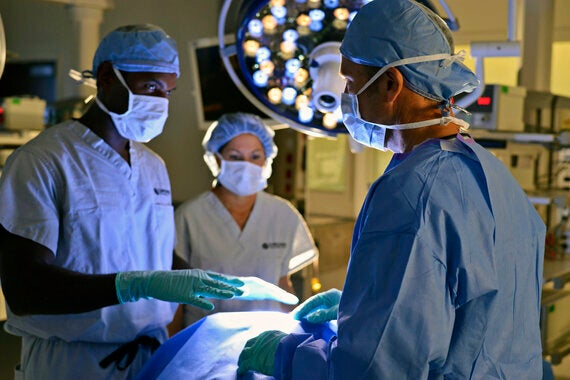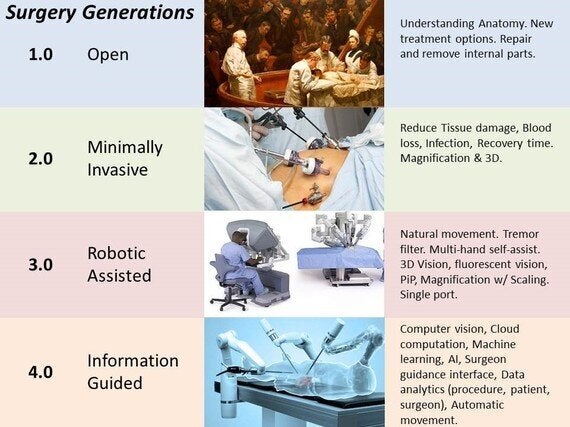
Hollywood has conditioned the population to believe that successful surgery depends solely on the skills and actions of a single MD surgeon. That is a simplification which discounts the contributions of the anesthesiologist, circulating nurse, bedside assistant, and instrument technician, to name a few. Brilliant surgeons have always relied on assistance from multiple well-educated staff members, and increasingly on the contributions of advanced medical devices. One of the most recent and powerful of these devices has been the surgical robot, such as the Intuitive da Vinci, Mazor Renaissance, and Make Rio. Each of these enables a surgeon to perform actions which would be more difficult or impossible with lesser instruments. Like a good bedside assistant, these allow the surgeon to tackle cases which may have been more risky or time consuming without this help.
But most people do not realize that the role of robotic assistance in surgery and other forms of medicine is just beginning. The da Vinci was the first robot to significantly impact hundreds of thousands of cases per year, but it is the forerunner of a wave of assistive devices that will be entering the market and the hospital. There are at least half a dozen surgical robots scheduled to emerge in the next few years. Each of these offers a slightly different set of capabilities, targets a unique set of procedures, and impacts the finances of hospital and patient alike.
In other fields, robotic systems offer improved precision, faster learning curves, increased speed, augmented sensing, repeatability, consistency, and real time data collection. The next generation of surgical robots will follow this trend with considerably more automation than we have seen in the da Vinci. To start, the robot will be much more aware of what it is doing. Currently all vision and force sensors deliver information only to the surgeon; the robot perceives none of this. In the future, the robot will be informed of the surgery being performed, it will maintain an awareness of the position and movements of its instruments, video images will be stored and processed in real time, and forces between the instruments and tissue will be captured.

All of this will be processed by hundreds or thousands of computers in the cloud so the robotic system will be almost as aware of the procedure as the surgeon. When combined with a database of thousands of similar procedures, the robot and its "cloud brain" will provide advice, guidance, and warnings to the human surgeon. It will eventually go so far as to prevent dangerous actions and even carry out small pieces of the procedure automatically without the assistance of the human surgeon. These technologies are far from replacing a human surgeon, however. They will enhance their capabilities, making them safer practitioners, capable of tackling more difficult situations and delivering more consistent results - all of which are beneficial to the patient, surgeon, hospital, and society.
The results of every surgery will become part of the cloud-based knowledge system which is used to guide other surgeons doing similar procedures. So, what is learned is immediately beneficial to all surgeons throughout the world, effectively making every procedure more successful because the robot and its cloud-brain are constantly becoming better in real time. They do not have to wait until these details are presented at a conference or published in a journal, because the information is immediately integrated into the cloud-brain.
Hospitals, surgeons, insurance companies, and lawyers will all be concerned and interested in the increasing participation of the robotic system, just as stakeholders are currently interested in the impact of self-driving cars. The new robots will be challenged to demonstrate their positive contributions and the limitations of any negative consequences that they bring to the equation. When a computer is involved in the procedure, everything that occurs can and will be recorded and stored. Detailed knowledge will benefit both the robotic system in learning and the patient in understanding what happened to them.
Within a few years, many more surgical procedures will include this new mechanical clinician that augments the surgeon's capabilities. The machine will become increasingly smarter, able to offer more support, more in-depth advice, and keep better records of what occurred. Surgeons, patients, and the population as a whole will be faced with significantly more capable devices. If we trust robots on the road, can we trust them in the operating room? Is there a limit to the amount of robotic autonomy we'll allow? And, can surgeons adapt to work cohesively with an artificially intelligence assistant?
Roger Smith, PhD, is Chief Technology Officer for the Florida Hospital Nicholson Center and a graduate faculty member at the University of Central Florida.